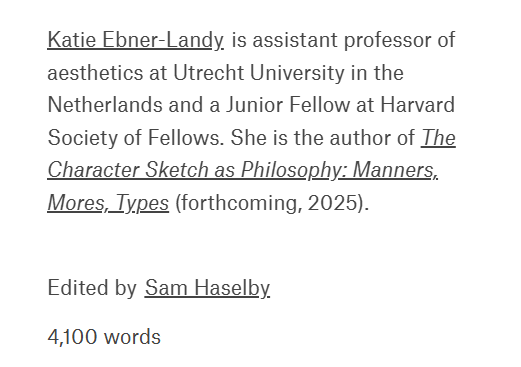David Hume vs literature [View all]
 Hume distrusted literature and worked to discredit character sketches as legitimate forms of philosophy
https://aeon.co/essays/how-david-hume-split-literature-from-philosophy
Hume distrusted literature and worked to discredit character sketches as legitimate forms of philosophy
https://aeon.co/essays/how-david-hume-split-literature-from-philosophy
 The Connoisseurs (1783) by David Allan. Courtesy the National Galleries of Scotland
The Connoisseurs (1783) by David Allan. Courtesy the National Galleries of Scotland

It is hard to find a philosopher who writes well. One can list the good stylists on one hand:
Bernard Williams, for the clear frankness of his prose; Stanley Cavell, whose writing self-reflectively folds in on itself like origami;
Friedrich Nietzsche, whose dazzle and exclamation seduce many people into questionable ideas.
David Hume is typically seen as part of this crowd. The 18th-century Scottish philosopher wrote in many genres: not only essays, dissertations and treatises, but dialogues, impersonated monologues and biographies. Hume adored the literary celebrities of his day, like the essayist
Joseph Addison, who founded
The Spectator magazine, and the French moralist Jean de La Bruyère. He was also unfailingly committed to finding a way to bridge the divide between scholars and society, between a world that was ‘learned’ and one that was ‘conversible’. However, it was Hume who helped to divide what we now call ‘literature’ from what we now call ‘philosophy’. He did so by posing a devastating challenge to the prestige of one literary tool that had long been considered a legitimate method in which to practise philosophy: the character sketch.
 Characters and Caricaturas (1743) by William Hogarth. Courtesy the Met Museum, New York
Characters and Caricaturas (1743) by William Hogarth. Courtesy the Met Museum, New York
What is a character sketch? It is a short description of a person, a social type, which focuses on their habitual preferences and behaviours. Imagine describing a type of person: an incel, an intellectual, a mansplainer. You might start by saying that they are ‘the kind of person who…’ The incel is a kind of person who lives in their parents’ basement, who knows the latest memes, and who politically probably leans far Right, or at least libertarian. The intellectual is the kind of person who likes good coffee shops, reads high-brow magazines, and who politically finds themselves leaning liberal, or far Left. The mansplainer, to borrow the journalist Marin Cogan’s memorable expression, is the kind of person who has a ‘need to explain to you – with the overly simplistic, patient tone of an elementary school teacher – really obvious shit you already knew.’
The character sketch is a genre that is descriptive by nature, and that today reads as a little sociological, a little literary, and more than a little comic. While a part of our everyday discourse, this genre has a long history, stretching all the way back to ancient Greece. Over the course of this history, the character sketch became entangled with another discipline entirely: moral philosophy, the branch of philosophy concerned with virtues and vices, with thinking about social customs and mores, and altogether with trying to work out what it takes to become good. For hundreds of years, the character sketch was understood as a standard method of practising this form of philosophy – until Hume challenged this assumption in 1748. With this, philosophy and literature started to split.
The ancient Greek thinker who should be credited with establishing this curious form of writing is a little-known philosopher called Theophrastus, who sits within the canon of great philosophical stylists. His name, given to him late in life by his teacher Aristotle, means ‘divine speaker’. (He was formerly called Euphrastus or ‘good speaker’ but then he got upgraded.) Theophrastus directed his writerly talents to a dizzying range of topics. He wrote treatises on juice, as well as works of metaphysics, logic and politics. He is most renowned, however, for two things: inventing the science of botany, and writing a very short book that came to be known as the
Characters.
snip



